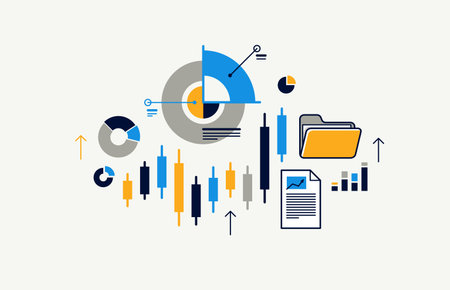1. Origins and Evolution of the U.S. Stock Market
The story of the U.S. stock market starts way back in the late 1700s, right after America gained independence. The journey began on May 17, 1792, with a simple agreement called the Buttonwood Agreement. Twenty-four stockbrokers met under a buttonwood tree on Wall Street in New York City and decided to create a system for trading stocks and bonds. This moment is widely recognized as the birth of what would become the New York Stock Exchange (NYSE).
The Early Days: Buttonwood Agreement to NYSE
After the Buttonwood Agreement, trading gradually became more organized. In 1817, the brokers formalized their group as the New York Stock & Exchange Board, which later evolved into today’s NYSE. Early trading was done face-to-face and focused mainly on government bonds and a few company stocks.
Key Historical Milestones
| Year | Event |
|---|---|
| 1792 | Buttonwood Agreement signed by 24 brokers on Wall Street |
| 1817 | Formation of the New York Stock & Exchange Board (later NYSE) |
| 1867 | First stock ticker invented, speeding up information flow |
| 1929 | The Great Crash leads to major regulation changes |
| 1971 | Launch of NASDAQ, first electronic stock market |
| 2006 | NYSE becomes a publicly traded company itself |
The Rise of Electronic Trading and Modern Markets
The late 20th century brought huge changes. The introduction of computers and electronic trading platforms like NASDAQ made buying and selling stocks faster and more accessible to everyday Americans. Today, millions participate in the stock market using online brokerages and mobile apps.
Main U.S. Stock Exchanges Today
| Exchange Name | Founded | Main Focus |
|---|---|---|
| New York Stock Exchange (NYSE) | 1792 | Large established companies (“blue chips”) |
| NASDAQ | 1971 | Technology and growth companies |
| CBOE Global Markets (Chicago Board Options Exchange) | 1973 | Options and derivatives trading |
A Transforming Marketplace
The U.S. stock market has changed dramatically since those early days under the buttonwood tree. What started as a small club for local traders has grown into a massive, global network that shapes not just the American economy, but financial markets worldwide.
2. Major U.S. Stock Exchanges and Indexes
The U.S. stock market operates through several major exchanges and indexes that help investors track performance and trade shares of companies. Understanding these marketplaces and benchmarks is essential for anyone interested in American investing.
Central Stock Exchanges
The two biggest and most influential stock exchanges in the United States are the New York Stock Exchange (NYSE) and NASDAQ. Each has its own unique features and history.
| Exchange | Founded | Key Features | Types of Companies Listed |
|---|---|---|---|
| New York Stock Exchange (NYSE) | 1792 | Oldest, largest by market cap; traditional floor trading with electronic systems | Mainly established, blue-chip companies like Coca-Cola, IBM, and Walmart |
| NASDAQ | 1971 | All-electronic; known for fast trades and tech-focused listings | Many technology giants such as Apple, Microsoft, Amazon, Google (Alphabet) |
| Cboe Global Markets (formerly BATS) | 2005 (as BATS) | Electronic trading platform; focuses on innovative market solutions | Diverse mix including ETFs and smaller firms |
| OTC Markets Group | 1913 (as National Quotation Bureau) | No centralized exchange floor; online trading of smaller or foreign companies not listed elsewhere | Penny stocks, international firms, smaller U.S. companies |
Prominent U.S. Stock Market Indexes
Stock indexes serve as barometers for the overall health of the market or specific sectors. The most widely followed indexes in the U.S. include:
| Index Name | Description | No. of Companies Included | Main Focus or Sector Representation |
|---|---|---|---|
| S&P 500 | A collection of 500 large-cap U.S. companies; widely used benchmark for the entire market’s performance. | 500 | Diverse: technology, healthcare, finance, consumer goods, energy, etc. |
| Dow Jones Industrial Average (DJIA) | An index tracking 30 significant publicly traded U.S. companies; often called “the Dow.” Oldest U.S. index still in use. | 30 | Mainly blue-chip industrials and leaders from various key sectors. |
| NASDAQ Composite Index | Covers all stocks listed on the NASDAQ exchange; heavy focus on tech companies. | Over 3,000+ | Mainly technology but also includes biotech, retail, and more. |
| Russell 2000 | An index tracking 2,000 small-cap companies in the U.S.; often used to gauge performance of smaller businesses. | 2,000 | Small-cap stocks across all industries. |
The Role of Stock Exchanges and Indexes in Investing
The NYSE and NASDAQ provide a marketplace for buying and selling shares, while indexes like the S&P 500 or Dow Jones offer quick snapshots of how groups of stocks are performing. By following these tools, investors can make more informed decisions about where to put their money.
Key Takeaways About U.S. Stock Exchanges and Indexes:
- The NYSE is known for traditional trading and listing big-name companies.
- NASDAQ is recognized for its electronic system and strong tech sector presence.
- Cboe Global Markets and OTC Markets Group serve specialized roles.
- S&P 500 and Dow Jones are top benchmarks for measuring overall market performance.
- Indexes help investors understand trends in different parts of the market or economy.
This overview covers the major marketplaces and key indexes that shape the landscape of the U.S. stock market—a crucial foundation for any investor looking to navigate American equities.

3. Market Structure and Trading Mechanisms
The U.S. stock market is a dynamic system that brings together buyers and sellers of stocks through well-established structures and rules. Understanding how stocks are listed, traded, and regulated can help investors navigate the market with confidence.
How Stocks Get Listed
Most stocks in the United States are listed on major exchanges such as the New York Stock Exchange (NYSE) or the Nasdaq. To be listed, companies must meet strict financial and regulatory requirements set by each exchange. These requirements often include minimum revenue, a certain number of shareholders, and regular financial disclosures. Once approved, companies issue shares that investors can buy and sell during trading hours.
Main U.S. Stock Exchanges
| Exchange | Location | Key Features |
|---|---|---|
| New York Stock Exchange (NYSE) | New York City | Oldest, largest by market cap, physical trading floor & electronic trading |
| Nasdaq | New York City | All-electronic, tech-heavy listings, fast order execution |
| Cboe Global Markets | Chicago | Known for options and ETF trading, electronic platform |
How Stocks Are Traded
Stock trading in the U.S. takes place primarily through two types of platforms: traditional exchanges (like NYSE) and electronic communications networks (ECNs). Most trades today are executed electronically for speed and efficiency.
Order Types Explained
Investors use different order types to buy or sell stocks based on their goals:
| Order Type | Description |
|---|---|
| Market Order | Buys or sells immediately at the best available price. |
| Limit Order | Buys or sells only at a specific price or better. |
| Stop Order (Stop-Loss) | Sells a stock when it reaches a specific price to limit losses. |
| Stop-Limit Order | Sells a stock at a specified price after reaching a trigger price. |
Trading Hours in the U.S.
The standard trading session for U.S. stocks runs from 9:30 AM to 4:00 PM Eastern Time (ET), Monday through Friday. However, many brokers offer pre-market (as early as 4:00 AM ET) and after-hours trading (until 8:00 PM ET), allowing investors more flexibility but often with lower liquidity and higher volatility.
| Session Type | Time (ET) |
|---|---|
| Pre-Market Trading | 4:00 AM – 9:30 AM |
| Main Trading Session | 9:30 AM – 4:00 PM |
| After-Hours Trading | 4:00 PM – 8:00 PM |
The Role of Electronic Trading & Market Makers
The rise of technology has transformed how trades are executed. Electronic trading platforms match buyers and sellers instantly, making transactions faster and more efficient than ever before.
What Are Market Makers?
A market maker is a firm or individual who stands ready to buy or sell a particular stock at publicly quoted prices. They help maintain liquidity by ensuring there’s always someone available to trade with you. Without market makers, buying or selling stocks quickly could become difficult—especially for less popular shares.
The Importance of Regulation
The Securities and Exchange Commission (SEC) oversees the entire U.S. stock market to protect investors from fraud and manipulation. Other important regulators include the Financial Industry Regulatory Authority (FINRA) and the exchanges themselves. These organizations set rules for fair trading practices, disclosure requirements, and broker conduct to keep the market safe and transparent for everyone.
4. Key Institutions and Participants
An Overview of the Major Players in the U.S. Stock Market
The U.S. stock market is a vast ecosystem made up of many different types of participants and institutions, each playing a unique role. Understanding these key players helps you see how the market works and why it operates the way it does. Here’s a breakdown of who’s involved:
Individual Investors
These are everyday people—like you and me—who buy and sell stocks through brokerage accounts. Individual investors can range from beginners with a few shares to experienced traders handling larger portfolios.
Institutional Investors
Institutional investors are large organizations that invest big sums of money on behalf of others. Examples include pension funds, insurance companies, and endowments. Their trades often influence stock prices because of the sheer size of their investments.
Brokerage Firms
Brokerage firms act as intermediaries, helping individuals and institutions buy and sell stocks. Some well-known U.S. brokerage firms include Charles Schwab, Fidelity, E*TRADE, and Robinhood. They provide trading platforms, research tools, and customer support.
Mutual Funds
Mutual funds pool money from many investors to buy a diversified portfolio of stocks, bonds, or other assets. These funds are managed by professionals who make investment decisions for the group.
Hedge Funds
Hedge funds also pool money from investors but tend to use more complex strategies to try to achieve higher returns. They often cater to wealthy individuals or institutions and can take bigger risks than mutual funds.
Regulatory Bodies: The SEC
The Securities and Exchange Commission (SEC) is the main government agency responsible for regulating the stock market in the United States. The SEC aims to protect investors, maintain fair markets, and facilitate capital formation by enforcing securities laws.
Summary Table: Key Players in the U.S. Stock Market
| Type of Participant | Main Role | Typical Example |
|---|---|---|
| Individual Investors | Buy/sell stocks for personal goals | A person investing through Robinhood |
| Institutional Investors | Invest large sums on behalf of clients/members | Pension fund or university endowment |
| Brokerage Firms | Facilitate stock trading for clients | Fidelity or Charles Schwab |
| Mutual Funds | Pool money to invest in diversified portfolios | Vanguard 500 Index Fund |
| Hedge Funds | Pursue high returns using advanced strategies | Bridgewater Associates |
| Regulatory Bodies (SEC) | Oversee market activities & enforce rules | Securities and Exchange Commission (SEC) |
Together, these participants keep the U.S. stock market running smoothly, providing opportunities for everyone from individual savers to massive institutions while maintaining fairness and transparency under regulatory oversight.
5. Cultural and Economic Significance
How the Stock Market Shapes American Life
The U.S. stock market is more than just a place for buying and selling shares—it plays a big role in shaping American culture, economics, and personal finance. Wall Street isn’t just a street in New York City; it’s often used as a symbol of the country’s economic strength and ambition. The ups and downs of the stock market are followed closely by millions of Americans and can even influence everyday conversations, news headlines, and national mood.
Trends in Stock Market Participation
Over the years, more Americans have started investing in the stock market, either directly or through retirement accounts like 401(k)s. Here’s a look at how stock market participation has changed:
| Year | % of U.S. Adults Owning Stocks | Main Ways People Invest |
|---|---|---|
| 1990 | 32% | Brokers, mutual funds |
| 2000 | 52% | 401(k)s, online trading rises |
| 2010 | 54% | Robo-advisors emerge |
| 2020 | 55% | Mobile apps, ETFs grow popular |
This rise in participation means that changes in the stock market can affect more households than ever before. When stocks go up, people may feel wealthier and spend more. If the market drops, it can make people more cautious with their money.
The Influence of Wall Street on Main Street
“Wall Street” refers to the world of big banks, investment firms, and major corporations. “Main Street” stands for regular people, small businesses, and local communities. Even though they seem different, what happens on Wall Street often impacts Main Street:
- Jobs: Many companies use money raised from stocks to grow and hire more workers.
- Savings: Retirement accounts depend on stock market performance.
- Confidence: A strong market can boost consumer confidence; a weak one can create worry.
- Innovation: Startups often rely on investors from Wall Street to fund new ideas that reach Main Street.
Cultural Impact: The American Dream and Investing
The stock market is closely linked to the idea of the “American Dream”—the belief that anyone can succeed through hard work and smart choices. For many Americans, investing in stocks is seen as a way to build wealth and secure their future. From TV shows about Wall Street to annual reports on retirement savings, stocks are part of daily life and conversation.
Key Takeaways for Everyday Americans
- You don’t have to be rich or an expert to invest—many tools now make it easier for everyone.
- The stock market affects jobs, home values, savings accounts, and even local businesses.
- Learning about stocks is becoming as important as learning how to budget or save money.


